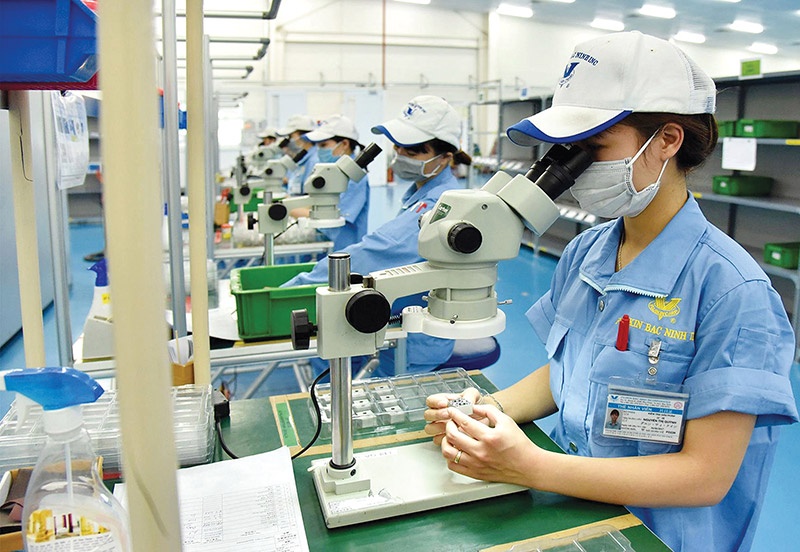MPI reviewing land-use stagnation
 |
| Many big foreign-invested groups will have their performance reviewed by authorised agencies, Photo: Dang Khoa |
The Ministry of Planning and Investment (MPI) on May 25 requested the people’s committees of cities and provinces to improve the quality of foreign direct investment (FDI) attraction and strengthen inspection and supervision.
Projects with the registered capital of $100 million or more, those with a usable land area of 50 hectares or more, and projects in the real estate sector in Hanoi, Ho Chi Minh City, Danang, Haiphong, Khanh Hoa, and Ba Ria-Vung Tau are subject to the review.
The MPI requests licensing agencies to report on capital contribution and disbursement; the implementation of the objectives specified in the investment certificates; the land-use situation, and the observance of the provisions of the laws on land and construction.
The MPI’s move will contribute to filtering out those projects which fail to meet the objectives outlined in the investment certificates or the laws.
The consolidated figures of the Foreign Investment Agency under the MPI showed that as of May 20, there were almost 35,000 valid foreign-invested projects with the total registered capital of over $426.1 billion. The disbursed capital reached almost $258 billion, equaling 60.7 per cent of the total.
During the last 35 years, a series of billion-dollar projects have been committed to Vietnam. The year 2008 was considered a heyday in attracting FDI, with 11 projects worth over $64 billion, tripling the figure from the previous year. However, numerous investment certificates for huge projects were either long-delayed or revoked entirely.
Nguyen Mai, chairman of the Vietnam Association of Foreign-Invested Enterprises, said that the remaining 40 per cent of the registered capital has yet to be disbursed. There is a large volume of unfeasible projects but their investment certificates have not been revoked.
“The government and localities need to recover unused land and revoke investment certificates for projects not complying with their commitments, leading to waste of land resources. This would pave the way for newly-registered capital,” Mai said.
Hoang Si Tuan, deputy director of Thanh Hoa Investment, Trade, and Tourism Promotion Agency, said, “Many foreign investors registered in Vietnam with the initial plan to keep the land and then look for local partners to develop the project. However, when they can’t find suitable partners, they often propose extending the implementation schedule and this only causes more delays.”
According to the MPI, real estate has been one of the hottest sectors for FDI inflows. In the January-May 20 period of this year, capital in real estate was almost $3 billion, ranking second among 18 sectors.
Among the six localities required to be reviewed, Ho Chi Minh City has the most foreign-invested real estate projects, with most coming from Singapore or South Korea.
Keppel Land, owned by Keppel Group (Singapore), has been developing many large-scale urban projects in Ho Chi Minh City. The most notable is the Empire City project in Thu Thiem, with 3,000 luxury apartments, offices, retail areas, and an 86-storey tower.
In Thu Duc city, Keppel Land funded Saigon Sports City with $500 million. This project aims to be the first sports-themed urban area in Vietnam and, although it was started in 2019, the project has seen almost no progress thus far.
Among South Korean developers, Lotte attracted the most attention with the Lotte Eco Smart City Thu Thiem, which includes a commercial centre, offices, hotels, serviced apartments, and high-class residential areas. After many adjustments, the current registered capital of the project is about $900 million.
GS E&C, another South Korean group, is establishing the Zeitgeist City project in Nha Be district. The project consists of five development stages and includes about 760 villas, 770 mid-range apartments, 13,000 luxury apartments, and 26,000 apartments.
In the west of Ho Chi Minh City, Celadon City from the Malaysian investor Gamuda Land is offering more than 7,000 apartments.
Meanwhile, in Hanoi, some golden land plots have been wasted for many years. In Ha Dong district’s Mo Lao urban area, a large apartment building project named Booyoung Vina has been abandoned for more than a decade. The project of the South Korean investor was licensed in 2006 and started construction the following year with six buildings. While two of these were built, the four remaining ones are still non-existent today.
What the stars mean:
★ Poor ★ ★ Promising ★★★ Good ★★★★ Very good ★★★★★ Exceptional
Related Contents
Latest News
More News
- Stress laid on high-quality FDI inflows (December 15, 2025 | 11:00)
- Can Tho utilises its growth advantages (December 15, 2025 | 09:09)
- Ca Mau unlocking potential to shape a more sustainable future (December 15, 2025 | 09:02)
- Major projects to be inaugurated nationwide (December 15, 2025 | 08:00)
- MoF workshop highlights mounting concerns over ODA on-lending costs (December 12, 2025 | 16:05)
- National Assembly approves pilot mechanisms to accelerate major projects in Hanoi (December 12, 2025 | 11:29)
- Legislation gives government flexibility for loan guarantees (December 11, 2025 | 18:04)
- Vietnam eases policy approval requirements, simplifies foreign and outbound investments (December 11, 2025 | 17:53)
- Vietnam masters core technologies of automobile value chain (December 11, 2025 | 17:46)
- VAL opens second line of largest soybean crushing complex in Southeast Asia (December 11, 2025 | 12:08)

 Tag:
Tag:






















 Mobile Version
Mobile Version